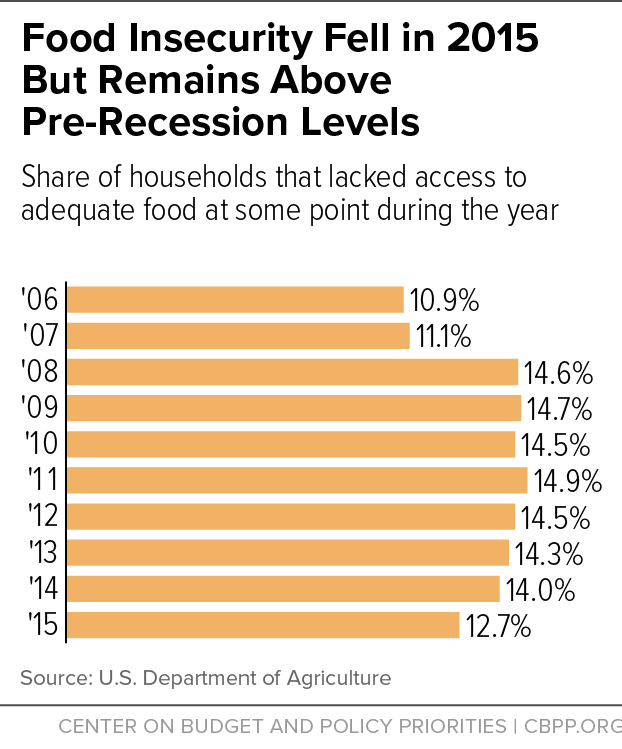BEYOND THE NUMBERS
The share of households experiencing food insecurity, meaning someone in the household had inadequate access to food at some point during the year, fell from 14.0 percent in 2014 to 12.7 percent in 2015, new Agriculture Department (USDA) data show, continuing a decline from 2011’s peak of 14.9 percent. But food insecurity remains above the pre-recession (2007) level of 11.1 percent (see graph), indicating that millions of Americans still face hardship.
Some 15.8 million households, containing roughly 42 million people, were food insecure last year.
While households with children had a higher food insecurity rate than households without children (16.6 percent versus 10.9 percent), they also saw a greater drop in food insecurity in 2015. The decline was especially big in households in which adults and children were food insecure. (In more than half of food-insecure households with children, only the adults are food insecure because adults often devote their limited food resources to their children.) The share of households with food-insecure children fell from 9.4 percent in 2014 to 7.8 percent in 2015 — the lowest since USDA began using current measuring methods in 1998.
The share of households with very low food security, a more severe form of food insecurity in which households have to take steps such as skipping meals because they lack resources, also fell in 2015 — after rising substantially in the recession and staying level since 2011. About 5 percent of households had very low food security, down from 5.6 percent in 2014 but still above the 2007 level of 4.1 percent.
These improvements may partly be due to low-income households finally benefiting from the economic recovery. In addition, low overall inflation, including low food price inflation and falling oil and gas prices in 2015, may have given families more room in their budgets for food.
Improvements in the safety net may have helped as well:
- Participation rates among eligible people in SNAP (formerly food stamps) continued growing through 2014, the most recent year available, and are especially high for families with children. Research shows that SNAP reduces food insecurity.
- The “community eligibility” option for high-poverty schools to offer breakfast and lunch at no charge to all students became available nationwide for the 2014-2015 school year. More than 18,000 schools adopted the option in 2015-2016.
- Health reform’s coverage expansions may have helped families with tight budgets put more resources towards food, particularly in states that expanded Medicaid. Research shows that food-insecure households often have to choose between paying for medical needs and food.
While the continued drop in food insecurity is certainly good news, 1 in 8 households struggled to put food on the table last year, including 1 in 6 households with children.

